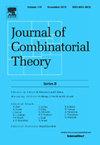Rigid partitions: From high connectivity to random graphs
IF 1.2
1区 数学
Q1 MATHEMATICS
引用次数: 0
Abstract
A graph is called d-rigid if there exists a generic embedding of its vertex set into such that every continuous motion of the vertices that preserves the lengths of all edges actually preserves the distances between all pairs of vertices. The rigidity of a graph is the maximal d such that the graph is d-rigid. We present new sufficient conditions for the d-rigidity of a graph in terms of the existence of “rigid partitions”—partitions of the graph that satisfy certain connectivity properties. This extends previous results by Crapo, Lindemann, and Lew, Nevo, Peled and Raz.
As an application, we present new results on the rigidity of highly-connected graphs, random graphs, random bipartite graphs, pseudorandom graphs, and dense graphs. In particular, we prove that random -regular graphs are typically d-rigid, demonstrate the existence of a giant d-rigid component in sparse random binomial graphs, and show that the rigidity of relatively sparse random binomial bipartite graphs is roughly the same as that of the complete bipartite graph, which we consider an interesting phenomenon. Furthermore, we show that a graph admitting disjoint connected dominating sets is d-rigid. This implies a weak version of the Lovász–Yemini conjecture on the rigidity of highly-connected graphs. We also present an alternative short proof for a recent result by Lew, Nevo, Peled, and Raz, which asserts that the hitting time for d-rigidity in the random graph process typically coincides with the hitting time for minimum degree d.
刚性分区:从高连通性到随机图
一个图被称为d刚性,如果它的顶点集在Rd中有一个一般的嵌入,使得顶点的每一个连续运动都保留了所有边的长度,实际上保留了所有顶点对之间的距离。图的刚性是最大的d,使得图是d刚性的。我们根据“刚性分区”的存在性,给出了图的d-刚性的新充分条件,即图的“刚性分区”满足某些连通性。这扩展了Crapo、Lindemann、Lew、Nevo、Peled和Raz之前的研究结果。作为应用,我们给出了关于高连通图、随机图、随机二部图、伪随机图和密集图的刚性的新结果。特别地,我们证明了随机Cdlog (d-正则图)是典型的d-刚性,证明了稀疏随机二项式图中存在一个巨大的d-刚性分量,并证明了相对稀疏随机二项式二部图的刚性与完全二部图的刚性大致相同,我们认为这是一个有趣的现象。进一步证明了一个包含(d+12)个不相交控制集的图是d刚性的。这意味着关于高连通图的刚性的Lovász-Yemini猜想的一个弱版本。我们还为Lew, Nevo, Peled和Raz最近的结果提供了一个替代的简短证明,该结果断言,随机图过程中d-刚性的命中时间通常与最小度d的命中时间一致。
本文章由计算机程序翻译,如有差异,请以英文原文为准。
求助全文
约1分钟内获得全文
求助全文
来源期刊
CiteScore
2.70
自引率
14.30%
发文量
99
审稿时长
6-12 weeks
期刊介绍:
The Journal of Combinatorial Theory publishes original mathematical research dealing with theoretical and physical aspects of the study of finite and discrete structures in all branches of science. Series B is concerned primarily with graph theory and matroid theory and is a valuable tool for mathematicians and computer scientists.

 求助内容:
求助内容: 应助结果提醒方式:
应助结果提醒方式:


